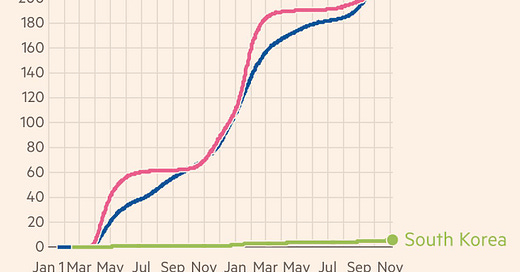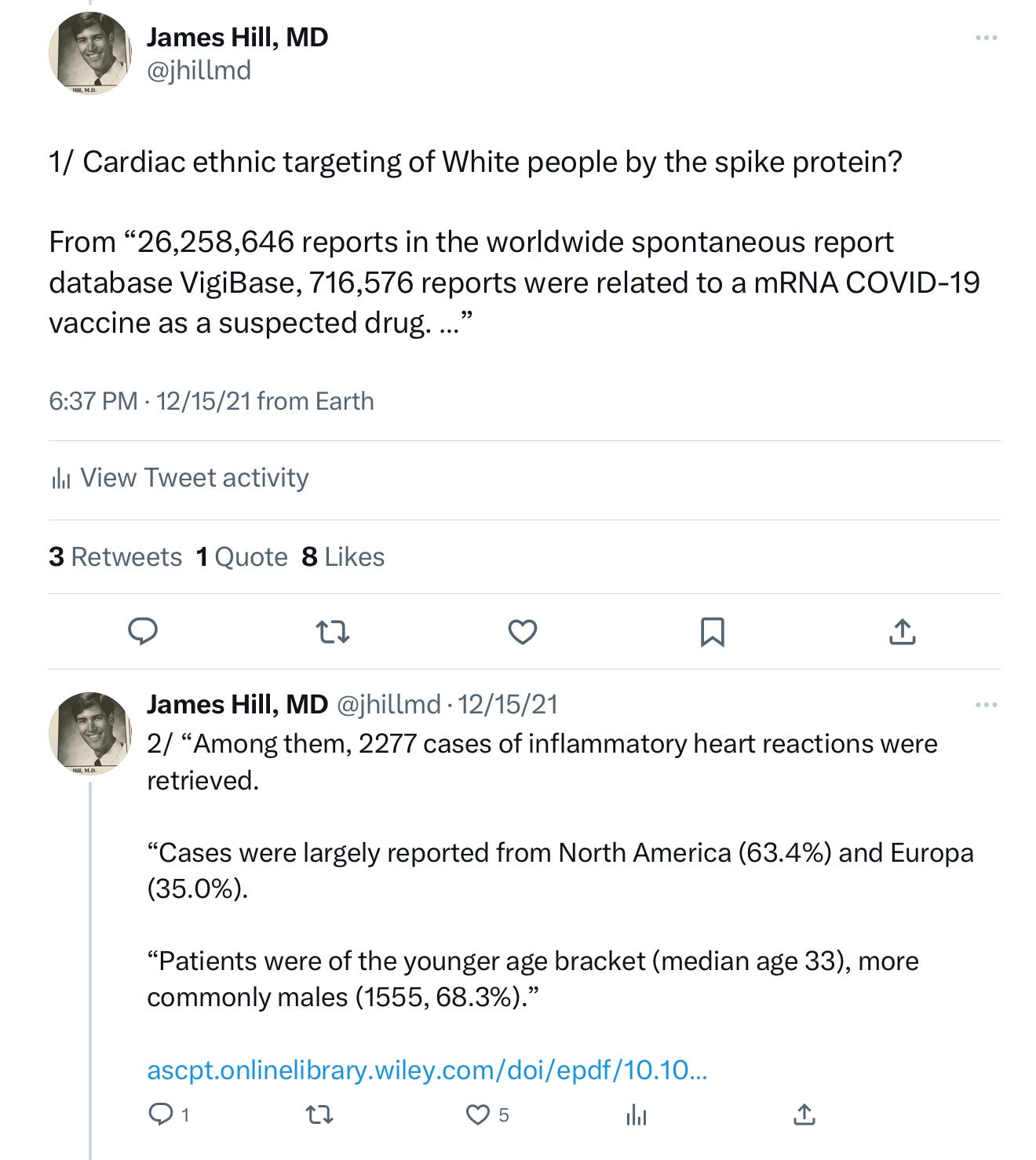Covid is an ethnic bioweapon
One group’s ACE2 genetic variants decrease binding with the spike protein. (Updated 4/26/25)
Some ethnic groups have genetic variants more resistant to SARS-CoV-2 spike protein binding to ACE2 and TMPRSS2 receptors than do others.
This does not imply everyone in any ethnic group is harmed or spared by effects of the spike protein.
We combined ACE2 coding variants' analysis in different populations and computational chemistry calculations to probe the effects on SARS-CoV-2/ACE2 interaction.
ACE2-K26R; most frequent in Ashkenazi Jewish population decreased the SARS-CoV-2/ACE2 electrostatic attraction. On the contrary, ACE2-I468V, R219C, K341R, D206G, G211R increased the electrostatic attraction; ordered by binding strength from weakest to strongest. …
The aforementioned variants are most frequent in East Asian, South Asian, African and African American, European, European and South Asian populations, respectively.
We found that the distribution of deleterious variants in ACE2 differs among 9 populations in gnomAD (v3).
Specifically, 39% (24/61) and 54% (33/61) of deleterious variants in ACE2occur in African/African-American (AFR) and Non-Finnish European (EUR) populations, respectively.
Prevalence of deleterious variants among Latino/Admixed American (AMR), East Asian (EAS), Finnish (FIN), and South Asian (SAS) populations is 2–10%, while Amish (AMI) and Ashkenazi Jewish (ASJ) populations do not appear to carry such variants in ACE2 coding regions.
Specifically, several variants, including p.Met383Thr, p.Pro389His, and p.Asp427Tyr, have been reported to slightly inhibit the interaction between ACE2 and the spike protein of SARS-CoV-1, which caused the first global SARS-CoV-1 outbreak.
Only AFR populations carry p.Met383Thr and p.Asp427Tyr variants, with allele frequencies of 0.003% and 0.01%, respectively.
The p.Pro389His only occurs in the AMR populations, with an allele frequency of 0.015%.
The p.Arg514Gly is a low allele frequency (0.003%) variant in AFR populations and is also somatically mutated in colon cancers and melanomas from The Cancer Genome Atlas (TCGA: https://portal.gdc.cancer.gov).
We identified three novel nonsynonymous variants predicted to alter ACE2 function, and showed that three variants (p.K26R, p.H378R, p.Y515N) alter receptor affinity for the viral Spike (S) protein. Variants p.K26R and p.N720D are more prevalent in the European population (p < .001), but Y497H is less prevalent compared to East Asians (p = .020).
A study reported ACE2 variants in two populations, Caucasians and Asians, and their possible effect on SARS-CoV-2 infection Rojas et al. (2020).
Their results showed that two mutations have different frequencies in these two races, affecting ACE2 binding to spike protein.
In another study on ACE2 variants in different ethnicities, Lys26Arg mutation in Ashkenazi Jews reduced ACE2 affinity, in contrast to mutations in other populations, including East Asian (Ile468Val), South Asian (Arg219Cys), African and African American (Lys341Arg), European (Asp206Gly), European and South Asian (Gly211Arg) (Ali et al., 2020).
In an independent study, ACE2 genotypes in Africa and Eastern Mediterranean population were considered protective against COVID-19 (Karahalil and Elkama, 2020).
In a cohort of Russian patients infected by COVID-19, three rare variants (rs146598386, rs755766792, rs73195521) may affect SARS-CoV-2 infection outcome were found (Shikov et al., 2020).
Demographics and characteristics of cases
As of the end of June 2021, of a total of 26,258,646 reports registered in the worldwide spontaneous report database VigiBase, 716,576 reports were related to an mRNA COVID- 19 vaccine as a suspected drug, including 495,493 with tozinameran and 221,368 with elasomeran (including 285 reports with both vaccines).
Among them, 2,277 cases of inflammatory heart reactions were retrieved, such as 1,241 (54.5%) myocarditis, 851 (37.4%) pericarditis, 167 (7.3%) myopericarditis, and 18 (0.8%) pleuropericarditis (Table 1).
Cases were largely reported from North America (63.4%) and Europe (35.0%).
Africans (AFR) showed the highest AFs [allele frequencies] for the LoF [loss-of-function] variants across populations.
Similarly, the Swedish population exhibited the highest AF for LoF variants among the Europeans.
Regarding the non-synonymous pathogenic variants, we observed the highest AF among the Ashkenazi Jewish (ASJ) population, while the Finnish (FIN) showed the highest AF among European subpopulations.
The AFs of non-synonymous variants classified as benign (198/334, 59.3%) were similarly distributed among the different populations.
Large variations in calculated binding energy in different ACE2 variants towards SARSCoV-2S protein have been reported.
The calculated binding energies can be ranked from high to low with the corresponding population with the highest allele frequency: G211R (European, South Asian), D206G (European), K341R (African, African American), R219C (South Asian), I468V (East Asian), K26R (Ashkenazi Jews).
These findings give indications regarding the populations that could be more prone to SARS-CoV-2 infection due to enhanced binding affinity.
Frequencies of the ACE2 variants associated with COVID-19 comorbidities are higher in the European and the admixed American populations.
These variants are also present with stronger pairwise linkage disequilibrium (LD) in the European and the admixed American populations.
On the other hand, the variants with protective role are more prevalent in the East and the South Asian populations.
Strong pairwise LD exists among the activity modifying (modifier) variants of the PIR and ACE2 genes only in the European super-population.
Absence of these PIRvariants in the South Asian population may contribute to the overall lower COVID-19 case fatality rates (CFR) despite the dense population in this region.








Support this work.
Ali F, Elserafy M, Alkordi MH, Amin M. ACE2 coding variants in different populations and their potential impact on SARS-CoV-2 binding affinity. Biochem Biophys Rep. 2020 Dec;24:100798.
Hou, Y., Zhao, J., Martin, W. et al. New insights into genetic susceptibility of COVID-19: an ACE2 and TMPRSS2 polymorphism analysis. BMC Med 18, 216 (2020).
Nirmal Vadgama, Alexander Kreymerman, et al. SARS-CoV-2 susceptibility and ACE2 gene variations within diverse ethnic backgrounds.
Bakhshandeh B, Sorboni SG, Javanmard AR, Mottaghi SS, Mehrabi MR, Sorouri F, Abbasi A, Jahanafrooz Z. Variants in ACE2; potential influences on virus infection and COVID-19 severity. Infect Genet Evol. 2021 Jun; 90:104773.
Chouchana, L., Blet, A., Al-Khalaf, M., Kafil, T.S., Nair, G., Robblee, J., Drici, M.-D., Valnet-Rabier, M.-B., Micallef, J., Salvo, F., Treluyer, J.-M. and Liu, P.P. (2022), Features of Inflammatory Heart Reactions Following mRNA COVID- 19 Vaccination at a Global Level. Clin. Pharmacol. Ther., 111: 605-613.
Roberta Russo, Immacolata Andolfo, Vito Alessandro Lasorsa, Achille Iolascon, and Mario Capasso. Genetic Analysis of the Coronavirus SARS-CoV-2 Host Protease TMPRSS in Different Populations, Front Genet. 2020; 11: 872.
Joris R. Delanghe, Marijn M. Speeckaert. Chapter Two: Host polymorphisms and COVID-19 infection. Advances in Clinical Chemistry, Volume 107, 2022.









From Ali et al.:
"The K26R variant which decreases the ACE2-virus binding was found to be most frequent in the Ashkenazi Jewish population (1.2%). "
I read: 1,2% of the jewish population has this mutation that mitigates disease from covid. Is that correct?
If this bioweapon was designed to not target jewish population, mitigation of disease for 1,2% of that population is not a big effect.
Hou finds a bigger difference:
"We found that the distribution of deleterious variants in ACE2 differs among 9 populations in gnomAD (v3). Specifically, 39% (24/61) and 54% (33/61) of deleterious variants in ACE2 occur in African/African-American (AFR) and Non-Finnish European (EUR) populations, respectively (Fig. 1b). Prevalence of deleterious variants among Latino/Admixed American (AMR), East Asian (EAS), Finnish (FIN), and South Asian (SAS) populations is 2–10%, while Amish (AMI) and Ashkenazi Jewish (ASJ) populations do not appear to carry such variants in ACE2 coding regions (Fig. 1b).”
But if this is a dark jewish setup, how come that in Israël they were the most fanatic with the vaccines?
And are there any signs that in the real world (and not computer models) this actually makes a difference?
FASCINATING.